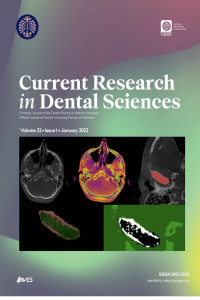EFFECT OF LENTULO SPIRAL USAGE AT DIFFERENT SPEEDS ON APICAL EXTRUSION OF CALCIUM HYDROXIDE
Apical extrusion, calcium hydroxide
___
- 1. Bystrom A, Sundqvist G. Bacteriologic evaluation of the efficacy of mechanical root canal instrumentation in endodontic therapy. Scand J Dent Res 1981;89:321-8.
- 2. Wu MK, Dummer PM, Wesselink PR. Consequences of and strategies to deal with residual post-treatment root canal infection. Int Endod J 2006;39:343-56.
- 3. Mohammadi Z, Dummer PM. Properties and applications of calcium hydroxide in endodontics and dental traumatology. Int Endod J 2011;44:697-730.
- 4. 4 Ok E, Ersoy İ, Altunsoy M, Kalkan A. Comparison of the vertical root fracture resistance of teeth treated with calcium hydroxide and ledermix paste. J Dent Fac Atatürk Uni 2016;26:52-7.
- 5. Estrela C, Mamede Neto I, Lopes HP, et al. Root canal filling with calcium hydroxide using different techniques. Braz Dent J 2002;13:53-6.
- 6. Siqueira JF, Jr., de Uzeda M. Influence of different vehicles on the antibacterial effects of calcium hydroxide. J Endod 1998;24:663-5.
- 7. Lindgren P, Eriksson KF, Ringberg A. Severe facial ischemia after endodontic treatment. J Oral Maxillofac Surg 2002;60:576-9.
- 8. De Bruyne MA, De Moor RJ, Raes FM. Necrosis of the gingiva caused by calcium hydroxide: a case report. Int Endod J 2000;33:67-71.
- 9. Sharma S, Hackett R, Webb R, et al. Severe tissue necrosis following intra-arterial injection of endodontic calcium hydroxide: a case series. Oral Surg Oral Med Oral Pathol Oral Radiol Endod 2008;105:666-9.
- 10. Ahlgren FK, Johannessen AC, Hellem S. Displaced calcium hydroxide paste causing inferior alveolar nerve paraesthesia: report of a case. Oral Surg Oral Med Oral Pathol Oral Radiol Endod 2003;96:734-7.
- 11. Nelson Filho P, Silva LA, Leonardo MR, et al. Connective tissue responses to calcium hydroxide-based root canal medicaments. Int Endod J 1999;32:303-11.
- 12. Estrela C, Pimenta FC, Ito IY, et al. In vitro determination of direct antimicrobial effect of calcium hydroxide. J Endod 1998;24:15-7.
- 13. Safavi KE, Nichols FC. Effect of calcium hydroxide on bacterial lipopolysaccharide. J Endod 1993;19:76-8.
- 14. Anthony DR, Senia S. The use of calcium hydroxide as temporary paste fill. Texas Dental J 1981;8:6-10.
- 15. Cvek M, Hollender L, Nord CE. Treatment of non-vital permanent incisors with calcium hydroxide. VI. A clinical, microbiological and radiological evaluation of treatment in one sitting of teeth with mature or immature root. Odontologisk revy 1976;27:93-108.
- 16. Dumsha TC, Gutmann JL. Clinical techniques for the placement of calcium hydroxide. Compend Contin Educ Dent 1985;6:482-9.
- 17. Lopes HP, Elias CN, Furtado CFP, et al. Emprego de instrumentos rotatórios no preenchimento de canais radiculares com pasta de hidróxido de cálcio. Rev Bras Odontol 1998;55:201-3.
- 18. Sigurdsson A, Stancill R, Madison S. Intracanal placement of Ca(OH)2: a comparison of techniques. J Endod 1992;18:367-70.
- 19. Webber RT, Schwiebert KA, Cathey GM. A technique for placement of calcium hydroxide in the root canal system. J Am Dent Assoc 1981;103:417-21.
- 20. Torres CP, Apicella MJ, Yancich PP, et al. Intracanal placement of calcium hydroxide: a comparison of techniques, revisited. J Endod 2004;30:225-7.
- 21. Deonízio M, Sydney G, Batista A, et al. Root canal filling with calcium hydroxide paste using lentullo spiral at different speeds. Dental Press Endod 2011;1:58-63.
- 22. Simcock RM, Hicks LM. Delivery of calcium hydroxide: comparison of four filling techniques. J Endod 2006;32:680-2.
- 23. Deveaux E, Dufour D, Boniface B. Five methods of calcium hydroxide intracanal placement: an in vitro evaluation. Oral Surg Oral Med Oral Pathol Oral Radiol Endod 2000;89:349-55.
- 24. Rahde N, Figueiredo JA, Oliveira EP. Influence of calcium hydroxide points on the quality of intracanal dressing filling. J Appl Oral Sci 2006;14:219-23.
- 25. Caliskan MK, Turkun M, Turkun LS. Effect of calcium hydroxide as an intracanal dressing on apical leakage. Int Endod J 1998;31:173-7.
- 26. Staehle HJ, Thomä C, Müller HP. Comparative in vitro investigation of different methods for temporary root canal filling with aqueous suspensions of calcium hydroxide. Endod Dent Traumatol 1997;13:106-12.
- Başlangıç: 1986
- Yayıncı: Atatürk Üniversitesi
İKİ KÖK VE İKİ KANALA SAHİP MANDİBULAR KANİN: İKİ OLGU RAPORU
Zeliha UĞUR, Kerem Engin AKPINAR, Demet ALTUNBAŞ
C. Neslihan EROĞLU, Serap KESKİN TUNÇ, Sadi ELASAN
Mehmet ADIGÜZEL, Pelin TÜFEKÇİ
EFFECT OF LENTULO SPIRAL USAGE AT DIFFERENT SPEEDS ON APICAL EXTRUSION OF CALCIUM HYDROXIDE
Tuğrul ASLAN, Salih DÜZGÜN, Yakup ÜSTÜN
Hatice ÖZDEMİR, Funda BAYINDIR
INCIDENCE OF MANDIBULAR AND MAXILLARY IMPACTED CANINES TRANSMIGRATION:A RETROSPECTIVE STUDY
